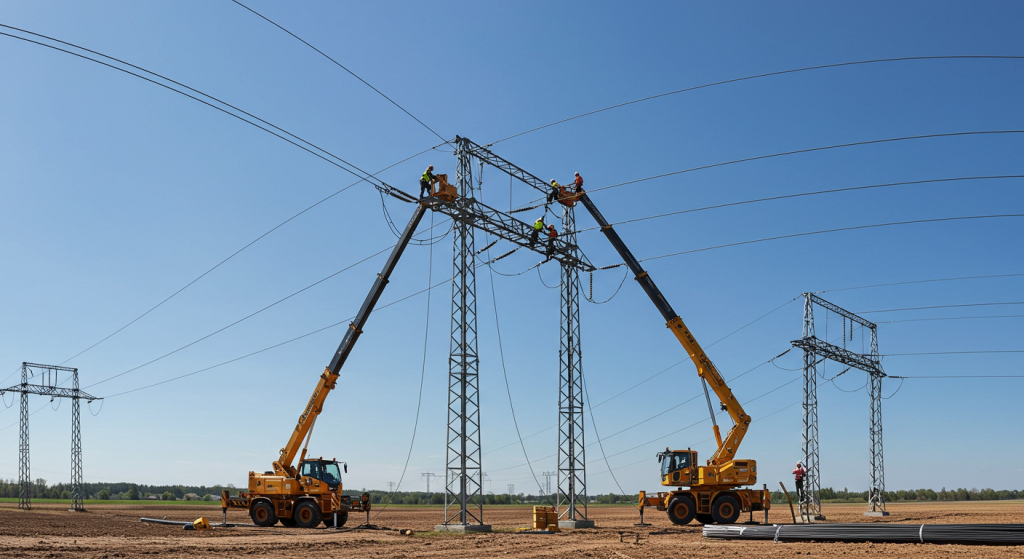Electric Tower Installation for Reliable Power Grids
2025-04-20
What is Electric Tower Installation?
The term electric tower installation contemplates the building and putting up of electric towers or pylons used to carry electricity over long distances. This construction is part of the electricity grid that helps in the seamless transfer of electricity from power plants to industries and homes. Now, with the rising demand for power and the ongoing shift towards renewable sources of energy, the reliable installation of power tower systems has become indispensable.
The Process of Electric Tower Installation
Every electric tower installation begins with a detailed and organized plan containing all the requisite tools and skilled personnel. Let us elaborate further:
1. Site Survey and Planning
As the name suggests, this is the preparation stage, which consists of all initial work and which in this case, would be finding the base of the tower. The survey involves inspection of soil, considering possible hazards, and getting all the relevant legislation to any applicable checks before construction. This phase involves preliminary work for other auxiliary supporting base infrastructure that is required in the yard.
2. Construction of the Tower’s Foundation
Once the site has been cleared, work on the foundation of the tower begins. The foundation bears the tower’s weight while providing it with support and guaranteeing stability. Depending on the soil conditions, the foundation may be constructed by pouring concrete or digging large holes with the purpose of placing steel anchor bolts. Building the tower’s foundation is one of the most vital parts of constructing a tower because it helps keep the tower stable in case of strong winds or earthquakes.
3. Assembly of the Tower
The next step in the process is erecting the tower, which starts after the foundation is put in place. After the preparations are done, the pieces of the tower are lifted and bolted to each other. The tower is typically constructed using steel or tubular steel poles. The process of erecting the tower involves building the metal components using bolts, nuts, and specially designed tools to ensure the absolute stability of the structure.
4. Raising the Tower
The next phase is physically positioning and raising the tower. Other tools for lifting include cranes and rigging equipment. These tools assist in placing the various sections of the tower into their proper positions. During this phase, crane operators and rigging specialists play a major part in the safe construction of the structure.
5. Erecting and Aligning the Tower
Once the tower has been completed, it should be aligned so that it is vertical and perfectly straight. This step is critical in ensuring that the structure can handle all the loads exerted by the power lines without any overstress or damage.
6. Mounting of the Conductors
After the tower is erected, the next activity is the mounting of the power lines, which are also referred to as conductors. This work is also known as conductor installation. The conductors are mounted between towers with the use of specialized tools and methods designed to ensure manual and automated continuity of electrical flow.

Types of Electric Towers
In the grid system, there are many various categories of electric towers that are tailored to unique purposes within the system.
1. Steel Frame Transmission Towers
These towers serve the function of supporting high-voltage electric power lines that are used in transmitting power from one region to the other. Their constructions are generally massive, hollow steel frameworks that endure powerful wind forces and heavy weight burdens.
2. Distribution Towers
Smaller than transmission towers, distribution towers transport electricity from substations to residences and establishments. They assist in delivering dependable power to consumers.
3. Self-Supporting Towers
Without needing guy wires for extra support, self-supporting towers stand independently. Common in cities where space is restricted, these towers require no additional support systems and are very sturdy.
4. Guyed Towers
Also known as guyed towers, these are supported by cables (guys) anchored to the ground. These towers are best suited for remote locations where space is not an issue, as they are affordable to install.
5. Lattice Towers
Lattice towers are a form of steel tower erection utilized in transmission lines. These towers have a triangular or square shape and consist of a grid-like structure made of steel. Lattice towers are a popular choice because of their strength and durability.
Tools and Technology for Putting Up Electric Towers
To install electric towers, a certain level of precision and focus is needed to minimize safety risks to a minimum. For this, the following tools are paramount:
• Heavy Duty Cranes: Used for lifting large tower components, these cranes position and install the components of the towers.
• Rigging Equipment: This encompasses cables, pulleys, and hoists that can be designed to lift the different sections of the towers and hold them in place.
• Bolting Tools: Components of the tower need to be connected and put together. These tools serve the purpose of ensuring the structure is well put together.
• Construction Vehicles: To put together the towers. These vehicles help in carrying the tools and parts to the place of installation.
• Safety Equipment: All workers at the site need to have safety harnesses and headgear. These, along with other protective equipment, are essential when working on towering structures or near power lines.
Advantages of Electric Tower Construction
The construction of electric towers has important advantages over the substations of electricity. Additional key features include:
1. Improved Reliability
Electric towers that are installed properly help with the easy routing or transmission of energy, which helps in reducing system failures or outages.
2. Systems of Power Work Efficiently
Towers that are adequately maintained and installed assist in the enhanced routing of electricity, which helps in its efficient usage.
3. New Regions Accessing Grid Power
Receiving regions can be added to the electricity supply using newly constructed electric towers, adding more coverage to the power grid.
4. Development of the Economy
Electric towers create numerous job opportunities which aid in the construction sector, engineering, and even in the maintenance of the towers. This greatly supports the economy.
Conclusion
The scope of work in electrical tower installations is readily available, though proper execution can only be achieved through collaboration with skilled professionals. In cases of complicated tasks such as power tower installations or high voltage tower erection, ensure you go for the right experts who observe safety protocols in their operations, alongside the skills required. We have additional resources on the subject of electric tower installation services, which can be found on our site, XY Tower.

Hey, I’m Chunjian Shu
"X.Y. Tower: Reliable, innovative solutions for high-quality towers and electrical equipment with professional service.
